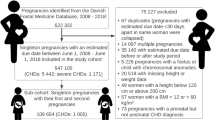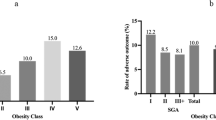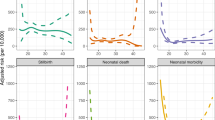Abstract
Objective:
Obesity is a risk factor for congenital heart defects (CHDs), but whether risk is independent of abnormal glucose metabolism remains unknown. Data on whether overweight status increases the risk are also conflicting.
Research Design and Methods:
We included 121 815 deliveries from a cohort study, the Consortium on Safe Labor (CSL), after excluding women with pregestational diabetes as recorded in the electronic medical record. CHD was identified via medical record discharge summaries. Adjusted odds ratios (ORs) for any CHD were calculated for prepregnancy body mass index (BMI) categories of overweight (25–<30 kg m−2), obese (30–<40 kg m−2) and morbidly obese (⩾40 kg m−2) compared with normal weight (18.5–<25 kg m−2) women, and for specific CHD with obese groups combined (⩾30 kg m−2). A subanalysis adjusting for oral glucose tolerance test (OGTT) results where available was performed as a proxy for potential abnormal glucose metabolism present at the time of organogenesis.
Results:
There were 1388 (1%) infants with CHD. Overweight (OR=1.15, 95% confidence interval (95% CI): 1.01–1.32), obese (OR=1.26, 95% CI: 1.09–1.44) and morbidly obese (OR=1.34, 95% CI: 1.02–1.76) women had greater OR of having a neonate with CHD than normal weight women (P<0.001 for trend). Obese women (BMI⩾30 kg m−2) had higher OR of having an infant with conotruncal defects (OR=1.34, 95% CI: 1.04–1.72), atrial septal defects (OR=1.22, 95% CI: 1.04–1.43) and ventricular septal defects (OR=1.38, 95% CI: 1.06–1.79). Being obese remained a significant predictor of CHD risk after adjusting for OGTT.
Conclusion:
Increasing maternal weight class was associated with an increased risk for CHD. In obese women, abnormal glucose metabolism did not completely explain the increased risk for CHD; the possibility that other obesity-related factors are teratogenic requires further investigation.
This is a preview of subscription content, access via your institution
Access options
Subscribe to this journal
Receive 12 print issues and online access
$259.00 per year
only $21.58 per issue
Buy this article
- Purchase on SpringerLink
- Instant access to full article PDF
Prices may be subject to local taxes which are calculated during checkout
Similar content being viewed by others
References
Blomberg MI, Kallen B . Maternal obesity and morbid obesity: the risk for birth defects in the offspring. Birth Defects Res A Clin Mol Teratol 2010; 88: 35–40.
Cedergren MI, Kallen BA . Maternal obesity and infant heart defects. Obes Res 2003; 11: 1065–1071.
Cedergren MI, Selbing AJ, Kallen BA . Risk factors for cardiovascular malformation—a study based on prospectively collected data. Scand J Work Environ Health 2002; 28: 12–17.
Gilboa SM, Correa A, Botto LD, Rasmussen SA, Waller DK, Hobbs CA et al. Association between prepregnancy body mass index and congenital heart defects. Am J Obstet Gynecol 2010; 202: 51.e1–51.e10.
Madsen NL, Schwartz SM, Lewin MB, Mueller BA . Prepregnancy body mass index and congenital heart defects among offspring: a population-based study. Congenit Heart Dis 2012; 8: 131–141.
Mills JL, Troendle J, Conley MR, Carter T, Druschel CM . Maternal obesity and congenital heart defects: a population-based study. Am J Clin Nutr 2010; 91: 1543–1549.
Stothard KJ, Tennant PW, Bell R, Rankin J . Maternal overweight and obesity and the risk of congenital anomalies: a systematic review and meta-analysis. JAMA 2009; 301: 636–650.
Waller DK, Shaw GM, Rasmussen SA, Hobbs CA, Canfield MA, Siega-Riz AM et al. Prepregnancy obesity as a risk factor for structural birth defects. Arch Pediat Adolesc Med 2007; 161: 745.
Watkins ML, Rasmussen SA, Honein MA, Botto LD, Moore CA . Maternal obesity and risk for birth defects. Pediatrics 2003; 111 (5 Pt 2): 1152–1158.
Riskin-Mashiah S, Younes G, Damti A, Auslender R . First-trimester fasting hyperglycemia and adverse pregnancy outcomes. Diab Care 2009; 32: 1639–1643.
Metzger BE, Lowe LP, Dyer AR, Trimble ER, Chaovarindr U, Coustan DR et al. Hyperglycemia and adverse pregnancy outcomes. N Engl J Med 2008; 358: 1991–2002.
Zhang J, Troendle J, Reddy UM, Laughon SK, Branch DW, Burkman R et al. Contemporary cesarean delivery practice in the United States. Am J Obstet Gynecol 2010; 203: 326.e1–326.e10.
Laughon SK, Branch DW, Beaver J, Zhang J . Changes in labor patterns over 50 years. Am J Obstet Gynecol 2012; 206: 419.e1–419.e9.
Botto LD, Lin AE, Riehle‐Colarusso T, Malik S, Correa A . Seeking causes: classifying and evaluating congenital heart defects in etiologic studies. Birth Defects Res A Clin Mol Teratol 2007; 79: 714–727.
Obstetricians ACo, Bulletins—Obstetrics GCoP, ACOG Practice Bulletin. Clinical management guidelines for obstetrician-gynecologists. Number 30, September 2001 (replaces technical bulletin number 200, December 1994). Gestational diabetes. Obstet Gynecol 2001; 98: 525–538.
Correa-Villasenor A, McCarter R, Downing J, Ferencz C . White-black differences in cardiovascular malformations in infancy and socioeconomic factors. The Baltimore-Washington Infant Study Group. Am J Epidemiol 1991; 134: 393–402.
How to use SAS for logistic regression with correlated data. Proceedings of the 27th Annual SAS Users Group International Conference (SUGI 27) 2002.
Correa A, Gilboa SM, Besser LM, Botto LD, Moore CA, Hobbs CA et al. Diabetes mellitus and birth defects, 2008 Am J Obstet Gynecol 199: 237.e1–237.e9.
Moore LL, Singer MR, Bradlee ML, Rothman KJ, Milunsky A . A prospective study of the risk of congenital defects associated with maternal obesity and diabetes mellitus. Epidemiology 2000; 11: 689–694.
Stothard KJ . Maternal overweight and obesity and the risk of congenital anomalies: a systematic review and meta-analysis. JAMA 2009; 301: 636–650.
Shaw GM, Todoroff K, Schaffer D, Selvin S . Maternal height and prepregnancy body mass index as risk factors for selected congenital anomalies. Paediatr Perinat Epidemiol 2001; 14: 234–239.
Shaw GM, Carmichael SL . Prepregnant obesity and risks of selected birth defects in offspring. Epidemiology 2008; 19: 616–620.
Strickland MJ, Riehle-Colarusso TJ, Jacobs JP, Reller MD, Mahle WT, Botto LD et al. The importance of nomenclature for congenital cardiac disease: implications for research and evaluation. Cardiol Young 2008; 18 (Suppl 2): 92–100.
KM F, MD C, BK K, CL O . Prevalence of obesity and trends in the distribution of body mass index among US adults, 1999-2010. JAMA 2012; 307: 491–497.
Kelly T, Yang W, Chen CS, Reynolds K, He J . Global burden of obesity in 2005 and projections to 2030. Int J Obes (Lond) 2008; 32: 1431–1437.
Acknowledgements
Institutions involved in the Consortium include, in alphabetical order: Baystate Medical Center, Springfield, MA; Cedars-Sinai Medical Center Burnes Allen Research Center, Los Angeles, CA; Christiana Care Health System, Newark, DE; Georgetown University Hospital, MedStar Health, Washington, DC; Indiana University Clarian Health, Indianapolis, IN; Intermountain Healthcare and the University of Utah, Salt Lake City, Utah; Maimonides Medical Center, Brooklyn, NY; MetroHealth Medical Center, Cleveland, OH; Summa Health System, Akron City Hospital, Akron, OH; The EMMES Corporation, Rockville, MD (Data Coordinating Center); University of Illinois at Chicago, Chicago, IL; University of Miami, Miami, FL; and University of Texas Health Science Center at Houston, Houston, Texas. The named authors alone are responsible for the views expressed in this manuscript, which does not necessarily represent the decisions or the stated policy of the NICHD. JB, SKL, JT and JM were supported by the Intramural Research Program of the Eunice Kennedy Shriver National Institute of Child Health & Human Development, National Institutes of Health. The data included in this paper were obtained from the Consortium on Safe Labor, which was supported by the Intramural Research Program of the Eunice Kennedy Shriver National Institute of Child Health and Human Development, National Institutes of Health, through Contract No. HHSN267200603425C.
Author information
Authors and Affiliations
Corresponding author
Ethics declarations
Competing interests
The authors declare no conflict of interest.
Additional information
Supplementary Information accompanies this paper on International Journal of Obesity website
Supplementary information
Rights and permissions
About this article
Cite this article
Brite, J., Laughon, S., Troendle, J. et al. Maternal overweight and obesity and risk of congenital heart defects in offspring. Int J Obes 38, 878–882 (2014). https://doi.org/10.1038/ijo.2013.244
Received:
Revised:
Accepted:
Published:
Issue Date:
DOI: https://doi.org/10.1038/ijo.2013.244



